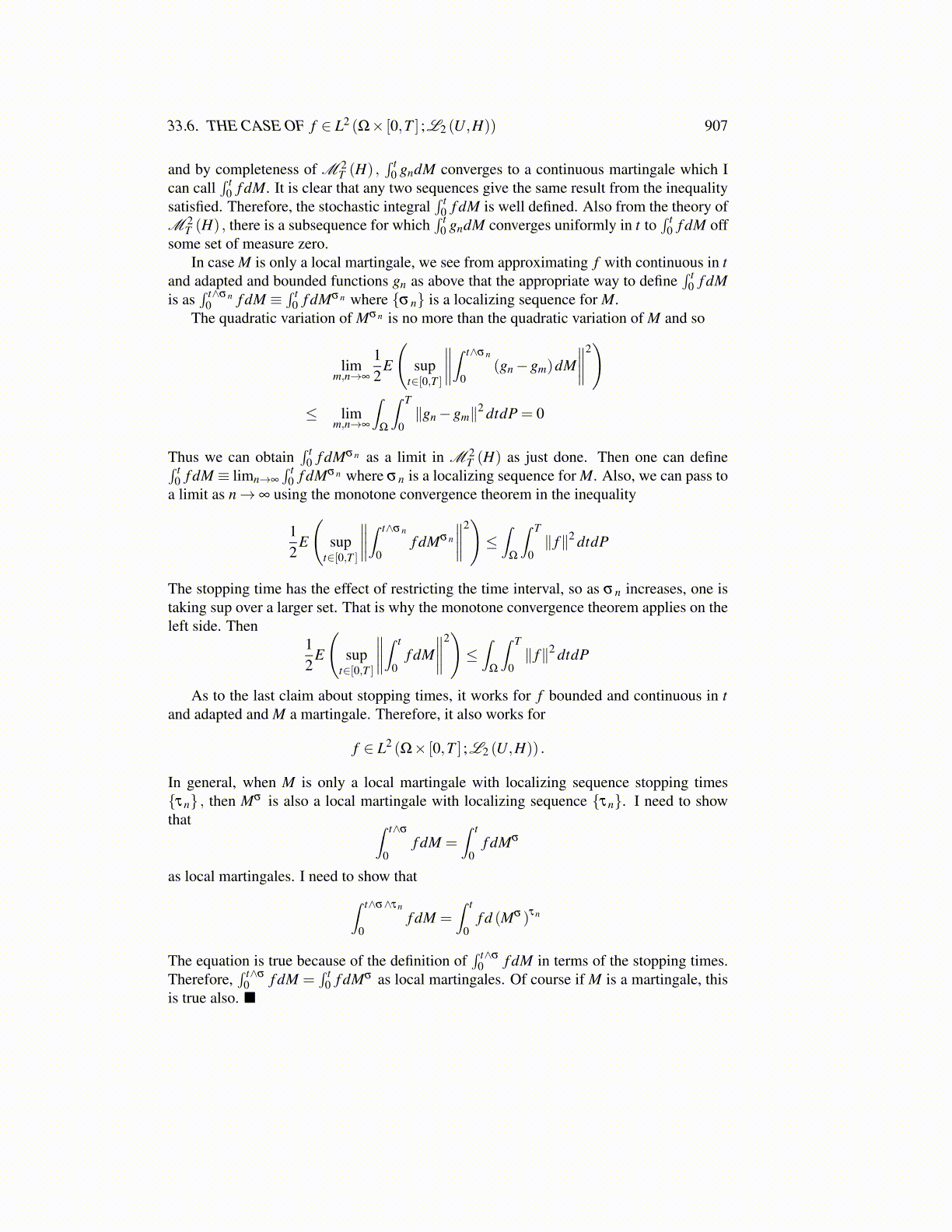
33.6. THE CASE OF f ∈ L2 (Ω× [0,T ] ;L2 (U,H)) 907
and by completeness of M 2T (H) ,
∫ t0 gndM converges to a continuous martingale which I
can call∫ t
0 f dM. It is clear that any two sequences give the same result from the inequalitysatisfied. Therefore, the stochastic integral
∫ t0 f dM is well defined. Also from the theory of
M 2T (H) , there is a subsequence for which
∫ t0 gndM converges uniformly in t to
∫ t0 f dM off
some set of measure zero.In case M is only a local martingale, we see from approximating f with continuous in t
and adapted and bounded functions gn as above that the appropriate way to define∫ t
0 f dMis as
∫ t∧σn0 f dM ≡
∫ t0 f dMσn where {σn} is a localizing sequence for M.
The quadratic variation of Mσn is no more than the quadratic variation of M and so
limm,n→∞
12
E
(sup
t∈[0,T ]
∥∥∥∥∫ t∧σn
0(gn−gm)dM
∥∥∥∥2)
≤ limm,n→∞
∫Ω
∫ T
0∥gn−gm∥2 dtdP = 0
Thus we can obtain∫ t
0 f dMσn as a limit in M 2T (H) as just done. Then one can define∫ t
0 f dM ≡ limn→∞
∫ t0 f dMσn where σn is a localizing sequence for M. Also, we can pass to
a limit as n→ ∞ using the monotone convergence theorem in the inequality
12
E
(sup
t∈[0,T ]
∥∥∥∥∫ t∧σn
0f dMσn
∥∥∥∥2)≤∫
Ω
∫ T
0∥ f∥2 dtdP
The stopping time has the effect of restricting the time interval, so as σn increases, one istaking sup over a larger set. That is why the monotone convergence theorem applies on theleft side. Then
12
E
(sup
t∈[0,T ]
∥∥∥∥∫ t
0f dM
∥∥∥∥2)≤∫
Ω
∫ T
0∥ f∥2 dtdP
As to the last claim about stopping times, it works for f bounded and continuous in tand adapted and M a martingale. Therefore, it also works for
f ∈ L2 (Ω× [0,T ] ;L2 (U,H)) .
In general, when M is only a local martingale with localizing sequence stopping times{τn} , then Mσ is also a local martingale with localizing sequence {τn}. I need to showthat ∫ t∧σ
0f dM =
∫ t
0f dMσ
as local martingales. I need to show that∫ t∧σ∧τn
0f dM =
∫ t
0f d (Mσ )τn
The equation is true because of the definition of∫ t∧σ
0 f dM in terms of the stopping times.Therefore,
∫ t∧σ
0 f dM =∫ t
0 f dMσ as local martingales. Of course if M is a martingale, thisis true also. ■